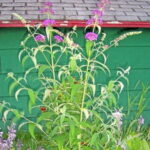Pruning Roses
Roses can grow fast in warm climates; do not neglect to prune your roses on a timely schedule. Removing dead and deformed canes leaves the healthy part of the rose to produce beautiful rose blooms.
When to Prune:
Prune roses after the last frost in your area. Months include January -April. Check your frost zone. If this is an old rose bush, prune only after the rose has bloomed on the old canes from last year.
Tools:
For cutting woody tissue use a fined tooth curved saw
Hand Shears
Lopping shears for thick canes
Heavy leather gloves, for protection from thorns.
If you are pruning miniature roses use hand pruners, for delicate roses use a delicate pair of shears.
Cutting:
Cut at a 30-45 degree angles. Make all cuts down to cane above the bud union or to the stem node. A bud eye is a small bulge with a tiny eye and a horizontal crease below. Watch the buds eye develop into a new shoot, and the direction of the buds growth. Keep cane directed from the interior of the plant so you do not create a tangle of canes competing for sunlight in the center. Make cuts ¼ inch above the bud. If cuts are too high above the bud, the cane wood above the bud will die, making a home for pest and disease. Make sure the cutting blade is on the underside to make a clean cut. The pressure on the non-cutting side should be on the top part of the discarded rose cane.
Rules of Pruning:
Pruning weak plants will stimulate growth
Roses for cut flowers prune heavy. Buds will produce a larger rose
Moderately pruning produces smaller rose flowers
Heavy pruning: cut back three or four canes-6-10 inches high. This will produce a few showy roses.
Moderate: five or twelve canes left at 18-24 inches high. Moderate pruning develops a larger bush than heavy pruning. Most garden roses should use this method.
Light: cut back one third of the rose plant. Light pruning produces short stem roses on bushes. This technique used on floribundas, grand flora, and first time hybrid teas. These methods take practice. Take good garden journal notes and adjust each year to the best method for your type of rose and zone you live in.
Guidelines for pruning your rose bushes:
Cut 1 inch below any evidence of disease
Check the top of each cane to make sure the pith in the center is creamy white, not brown or gray. Prune down to just above the bud where the pith is healthy or to the bud union. Any canes that grow straight out and up should be cut, or any cane growing toward the center of the rose bush. Remove all suckers or unsightly shoots that grow out of the rootstock below the bud union.
Pruning Climbing Roses:
Climbing roses have their own rules; do not prune climbers except deadwood for 2 or 3 years. Climbers need to establish mature cane. Prune climbers once after they have bloomed. Prune continuous roses early in the spring. Prune ramblers after they bloom. Rose climber canes are only good for two or three seasons at the most. Be sure to remove all suckers from the base of the climber. Cutting the canes that the flowers appear on back four or five buds, helps shape the plant. Prune while dormant if your climber is a hybrid. Removing only dead wood and sucker growth. Healthy canes in the amount of three or four remaining. Removing flowers off ever blooming roses, do not remove foliage on repeat blooms. On hybrids, leave two leaf buds on each flower shoot. Prune climbers to fit the space. For trellis and arbors let canes grow long and tying them in a horizontal position with cane tips pointed downward. For your next growing season, keep a detailed garden journal.






